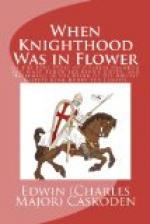* * * * *
The Author and The Book
BY MAURICE THOMPSON
When a man does something by which the world is attracted, we immediately feel a curiosity to know all about him personally. Mr. Charles Major, of Shelbyville, Indiana, wrote the wonderfully popular historical romance, When Knighthood was in Flower, which has already sold over a quarter million copies.
It is not mere luck that makes a piece of fiction acceptable to the public. The old saying, “Where there is so much smoke there must be fire,” holds good in the case of smoke about a novel. When a book moves many people of varying temperaments and in all circles of intelligence there is power in it. Behind such a book we have the right to imagine an author endowed with admirable gifts of imagination. The ancient saying, “The cup is glad of the wine it holds,” was but another way of expressing the rule which judges a tree by its fruit and a man by his works; for out of character comes style, and out of a man’s nature is his taste distilled. Every soul, like the cup, is glad of what it holds.
Mr. Major himself has said, in his straightforward way, “It is what a man does that counts.” By this rule of measurement Mr. Major has a liberal girth. The writing of When Knighthood was in Flower was a deed of no ordinary dimensions, especially when we take into account the fact that the writer had not been trained to authorship or to the literary artist’s craft; but was a country lawyer, with an office to sweep every morning, and a few clients with whom to worry over dilatory cases and doubtful fees.
The law, as a profession, is said to be a jealous mistress, ever ready and maliciously anxious to drop a good-sized stumbling block in the path of her devotee whenever he appears to be straying in the direction of another love. Indeed, many are the young men who, on turning from Blackstone and Kent in a comfortable law office to Scott and Byron, have lost a lawyer’s living, only to grasp the empty air of failure in the fascinating garret of the scribbler. But “nothing succeeds like success,” and genius has a way of changing rules and forcing the gates of fortune. And when we see the proof that a fresh genius has once more wrought the miracle of reversing all the fine logic of facts, so as to bring success and fame out of the very circumstances and conditions which are said to render the feat impossible, we all wish to know how he did it.
Balzac, when he felt the inspiration of a new novel in his brain, retired to an obscure room, and there, with a pot of villainous black coffee at his elbow, wrote night and day, almost without food and sleep, until the book was finished. General Lew Wallace put Ben Hur on paper in the open air of a beech grove, with a bit of yellowish canvas stretched above him to soften the light. Some authors use only the




